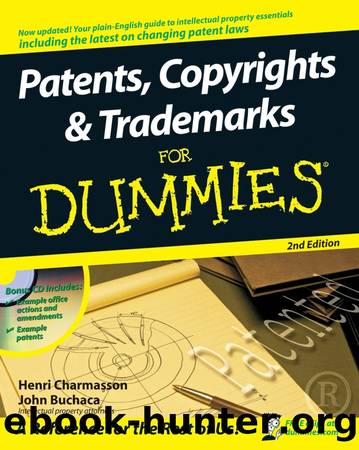Patents, Copyrights & Trademarks For Dummies® by Henri J. A. Charmasson

Author:Henri J. A. Charmasson [Charmasson, Henri J. A.]
Language: eng
Format: epub
Goodreads: 193497
Publisher: John Wiley & Sons, Ltd.
Published: 2010-03-17T07:00:00+00:00
Fixed creation of the mind
An OWA must be the result of creativity, originating in the author’s mind and not merely a discovery of something that already exists. Furthermore, the work isn’t considered “created” until it’s fixed, tangible, permanent, or stable, and reproducible or otherwise communicable. Here are some examples:
Making a natural-looking plaster-cast replica of a tree trunk to serve as a pedestal doesn’t require any mental creativity. But, composing a symphony that suggests wildlife sounds of a virgin forest requires many mental steps to select and arrange sounds in a pleasant composition.
Giving an ad-libbed speech or improvising a musical composition doesn’t result in a fixed creation and doesn’t qualify as an OWA unless it is recorded simultaneously.
Once upon a time, video games were denied copyright protection on the grounds that the moving images only occurred in response to the players’ commands and were therefore not fixed and reproducible. Eventually, the courts recognized that coded instructions stored on a computer chip dictate everything on the screen. By manipulating a joystick, the player selects a series of prerecorded or predetermined program sequences. Thus, the screen images aren’t only recorded, but are also reproducible at will.
For your own protection, you must fix your work as early as possible. If you’re developing a teaching method or an aerobic dance routine, have somebody record it as you go. If you created an original knitting design, take pictures of it. Keep track of the date you first fixed and distributed your OWA. You’ll need that information later, as we explain in Chapter 14.
Observing something and carefully listing its characteristics isn’t an OWA; it’s a mere representation of pre-existing conditions. For example, the diagnostic of a psychologist that details the personality profile of a patient can’t be protected by copyright.
Substantive and nontrivial mental activity
To qualify as an OWA, the work must have significant complexity, scope, length, or duration. To test compliance with this requirement, you have to use different measuring sticks, according to the nature of the work.
Written, pictorial, and nonmusical works must have a certain degree of complexity or length.
Titles, slogans, maxims, two-verse poems, and reproductions of common geometrical figures don’t meet the test. On those grounds, the slogan, “You got the right one, uh-huh,” used to promote the Pepsi brand of soda, was denied copyright protection. That was also the fate of the folder icon by Apple Computer, Inc., that depicts a common cardboard folder together with the term Waste Basket to identify a discarded folder.
A limerick barely passes the threshold of substantiality.
A simple line drawing of a dove by the hand of Pablo Picasso, however, is certainly complex (and original) enough to get copyright protection.
Sounds are measured with a shorter yardstick than words are. In a musical composition, a single distinctive bar or even one original measure may be sufficient to deserve protection. The four opening notes of Beethoven’s Symphony No. 5 that are used throughout the symphony are a case in point. They would have enough substance to deserve copyright protection if they were composed today.
Download
This site does not store any files on its server. We only index and link to content provided by other sites. Please contact the content providers to delete copyright contents if any and email us, we'll remove relevant links or contents immediately.
Patents, Copyrights & Trademarks For Dummies® by Henri J. A. Charmasson(275)
Content: Selected Essays on Technology, Creativity, Copyright, and the Future of the Future by Cory Doctorow(257)
Patent Management by Oliver Gassmann & Martin A. Bader & Mark James Thompson(244)
Intellectual Property, Cultural Property and Intangible Cultural Heritage by Christoph Antons William Logan(218)
